A sepal is a part of the flower of angiosperms. Usually green, sepals typically function as protection for the flower in bud, and often as support for the petals when in bloom.

The Aristolochiaceae are a family, the birthwort family, of flowering plants with seven genera and about 400 known species belonging to the order Piperales. The type genus is Aristolochia L.
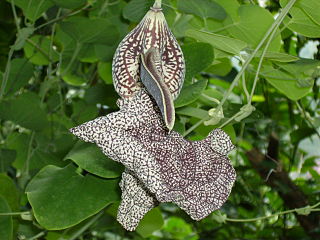
Aristolochia is a large plant genus with over 500 species that is the type genus of the family Aristolochiaceae. Its members are commonly known as birthwort, pipevine or Dutchman's pipe and are widespread and occur in the most diverse climates. Some species, like A. utriformis and A. westlandii, are threatened with extinction.

The City Botanic Gardens is a heritage-listed botanic garden on Alice Street, Brisbane City, City of Brisbane, Queensland, Australia. It was also known as Queen's Park. It is located on Gardens Point in the Brisbane CBD and is bordered by the Brisbane River, Alice Street, George Street, Parliament House and Queensland University of Technology's Gardens Point campus. It was established in 1825 as a farm for the Moreton Bay penal settlement.
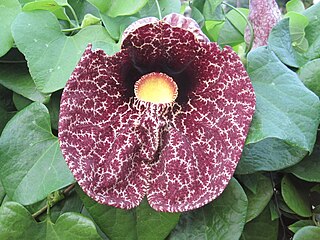
Aristolochia littoralis, the calico flower or مورپنکھ بیل or elegant Dutchman's pipe, is a species of evergreen vine belonging to the family Aristolochiaceae.
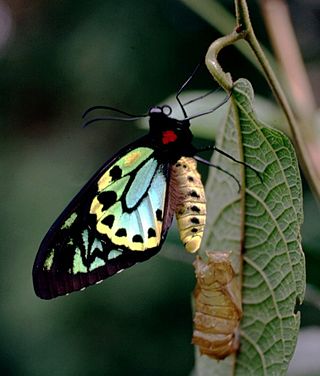
Ornithoptera richmondia, the Richmond birdwing, is a species of birdwing butterfly that is endemic to Australia. It is the second smallest of the birdwing species, the smallest being Ornithoptera meridionalis.
Pararistolochia schlechteri is a vine endemic to the Northern (Oro) Province of Papua New Guinea. Although its distribution is supposedly restricted to the Northern Province, there have been two rare accounts of occurrences in the Madang and East Sepik Provinces Papua New Guinea.
Aristolochia ceropegioides, synonym Pararistolochia ceropegioides, is a plant species of family Aristolochiaceae. It is found in Cameroon and Gabon. Its natural habitats are subtropical or tropical dry forests and subtropical or tropical moist lowland forests. It is threatened by habitat loss.

Pararistolochia is a genus of plant family Aristolochiaceae.

Aristolochia goldieana is a species of plant in the family Aristolochiaceae. It is found in Benin, Cameroon, Ghana, Guinea, Guinea-Bissau, the Gulf of Guinea Islands, Ivory Coast, Liberia, Nigeria, and Sierra Leone. Its natural habitat is subtropical or tropical moist lowland forests. It is threatened by habitat loss.
Aristolochia preussii, synonym Pararistolochia preussii, is a species of plant in the family Aristolochiaceae. It is native to Cameroon, Equatorial Guinea, Gabon, and Ivory Coast. Its natural habitat is subtropical or tropical dry forests. It was assessed as "critically endangered" and threatened by habitat loss in the 2000 IUCN Red List, where it is said to be native only to Cameroon. As of February 2023, Plants of the World Online gives it a wider distribution.

Aristolochia grandiflora, the pelican flower, is a deciduous vine with one of the world's largest flowers that emits an odor that smells like rotting feet, attracting flies.

Aristolochia praevenosa, synonym Pararistolochia praevenosa, is an Australian plant in the birthwort family, native to Queensland and New South Wales. The Richmond birdwing butterfly vine grows in subtropical rainforest in coastal areas north from Wollongbar, in far north eastern New South Wales and adjacent areas in south eastern Queensland. It has been recorded as far north as the Mary River. It also grows in tropical north eastern Queensland, where it is a food plant for the Cairns birdwing butterfly.
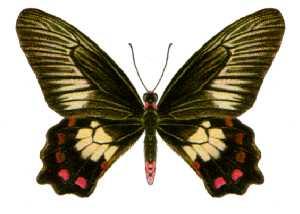
Pachliopta polydorus, the red-bodied swallowtail, is a butterfly from the family Papilionidae found in north-eastern Queensland, Australia and Papua New Guinea.

Austrocallerya megasperma, one of several species commonly known as native wisteria, is a species of flowering plant in the family Fabaceae and is endemic to eastern Australia. It is a woody climber with pinnate leaves and racemes of purple, pea-like flowers.

Pararistolochia enricoi is an endemic Malagasy species of plant in the birthwort family, the only belonging to the genus Pararistolochia within the Island.

Aristolochia macrocarpa, synonym Pararistolochia macrocarpa, is a species of flowering plant in the family Aristolochiaceae native to west and west-central tropical Africa.

Pseudolycopodium is a genus of lycophyte in the family Lycopodiaceae with only one species, Pseudolycopodium densum, known as the bushy clubmoss. In the Pteridophyte Phylogeny Group classification of 2016, the genus is placed in the subfamily Lycopodioideae. Some sources do not recognize the genus, sinking it into Lycopodium. Pseudolycopodium densum is native to Australia, the North Island of New Zealand and New Caledonia. It is a spore-bearing vascular plant and grows up to a metre high. It is found in a wide variety of situations, often in high rainfall areas on sandy soils.
Aristolochia paucinervis is a herbaceous plant in the family Aristolochiaceae endemic to the western Mediterranean Basin.


